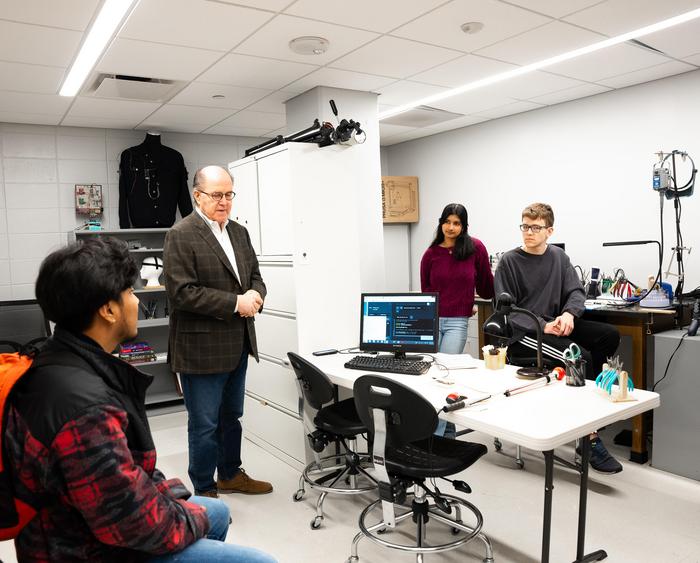Student researchers assist professor in developing haptic aids for the blind

In the basement of the Lillard Science Center, a small group of students are working to advance and develop technology for the visually impaired that will be both accessible and affordable.
Most people are familiar with haptics in the context of the gaming world. The buzz or vibration from the controller sends signals to the gamer about what is happening in the game. Lecturer Frederick Prete is applying haptics to create mobility aids for the visually impaired.
Prete and his students are currently developing a handheld cane that uses sensors to measure the proximity of nearby objects such as walls and other obstacles and send vibrations to the user of the cane to aid in navigating spaces. In addition to the cane, the team is also working on a wearable jacket with similar functions. Sensors on the jacket trigger vibrations that communicate distance and proximity of objects and people to the wearer, making it easier for them to navigate crowded spaces.
For Prete, this research and the end goal of a final product are the culmination of his academic career. Before pursuing a PhD, Prete was a special education teacher where he became familiar with the needs of students with visual impairments. The haptic mobility aids he is developing with the help of his students also speak to his interest in philosophy as well as psychology and biology.
“We are a very goal-oriented team,” Prete said. “We all feel committed to the same outcome. Our research is complex. There is a computer programming component, an electrical hardware and building component, and a component that involves testing our devices with potential users and volunteer subjects. These all require different sets of skills. Often, when interested students ask about the lab, they may be unfamiliar with one or more of these areas. However, there is a synergy among the research students and myself as we help and mentor each other through the learning process.”

If they want to try working in Prete’s haptics lab, they undertake specific projects that they have to work through. “It’s research,” Prete said. “They are solving problems.”
Five students worked in Prete’s lab in fall 2023: Lauren Steidl ’23, Suma Pasupulati ’24, Omar Kousa ’26, Nick Abraham ’27, and Tobi Ellis ’27. This semester, with Steidl having graduated in December, Emily Bross ’25, Ricardo Salazar ’25, and Will Cleveland ’26 have joined the team.
For Ellis, who uses a cane on a daily basis, working in Prete’s lab hits close to the heart.
“This research is so personal to me because I am blind,” the data science and music double major and legal studies minor said. “Being able to participate in research for something made for people like me has been a powerful experience.”

The haptics cane the team is developing is designed to expand the sensory world of the user. Alongside Prete, the students must account for different people's cane weight preferences as well as different reactions to varying haptic feedback options; some users have preferred a strong vibration, while others find too much haptic feedback to be overstimulating.
Prete's background as a biological psychologist and experience as a person with a visual impairment has been deeply informative to his work: “I have some sense of what the world is like. I have a perspective you would not have if you approached this from the engineering perspective alone.”
Pasupulati finds that working in the haptics mobility lab gets her closer to her biggest goal in life: helping people.
She devotes 10 hours a week to working with the team to gain practical experience and make a difference. The neuroscience and theater double major especially enjoys the hands-on aspects of the work and knows the skills she is honing will be directly applicable to her future work in bio-medicine.
“I love to solder and build things,” she said. “There are many times where things don’t go the way I want them to, such as times I write complex pieces of computer code and it doesn’t work. Sometimes things aren’t going to go my way, and I have learned to work around that.”
Both of Pasupulati’s majors support the work she does.
“Neuroscience and theater are both about really getting to the root of why people function and behave the way they do,” she explained. “These two fields interact in many ways most people don’t even realize.”

Prete agrees the skills students are gaining in the lab can give them a leg up on graduate school and job applications.
“This research integrates a variety of disciplines and skill sets,” he said. “The research moves far beyond biology, integrating disciplines as disparate as philosophy, computer science, psychology, and electrical engineering.”
The students are picking up new skills every day. Salazar has held an interest in technology since childhood. In the lab, he is able to explore different sides of his computer science major. “I have been learning about machine learning and reinforcement learning so the users of the cane can be more comfortable,” he said.
The research requires a variety of skill sets. Biology major Cleveland was recruited by Prete because of the insightful and nuanced understanding of sensory systems that he demonstrated in Prete’s Bio 136 course, Sensing the Environment. Cleveland appreciates that he’s learned so much about working with his hands. “I find that very satisfying,” he said.
Bross, a data science and chemistry double major with a minor in biology, finds that the research has helped her expand her world: “It’s been cool adding another way of sensing the environment, and I have loved seeing how fast the mind can integrate new information to help you move around.”

